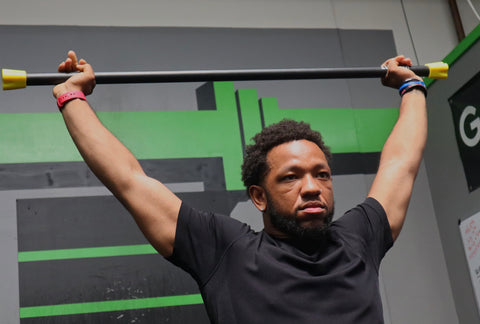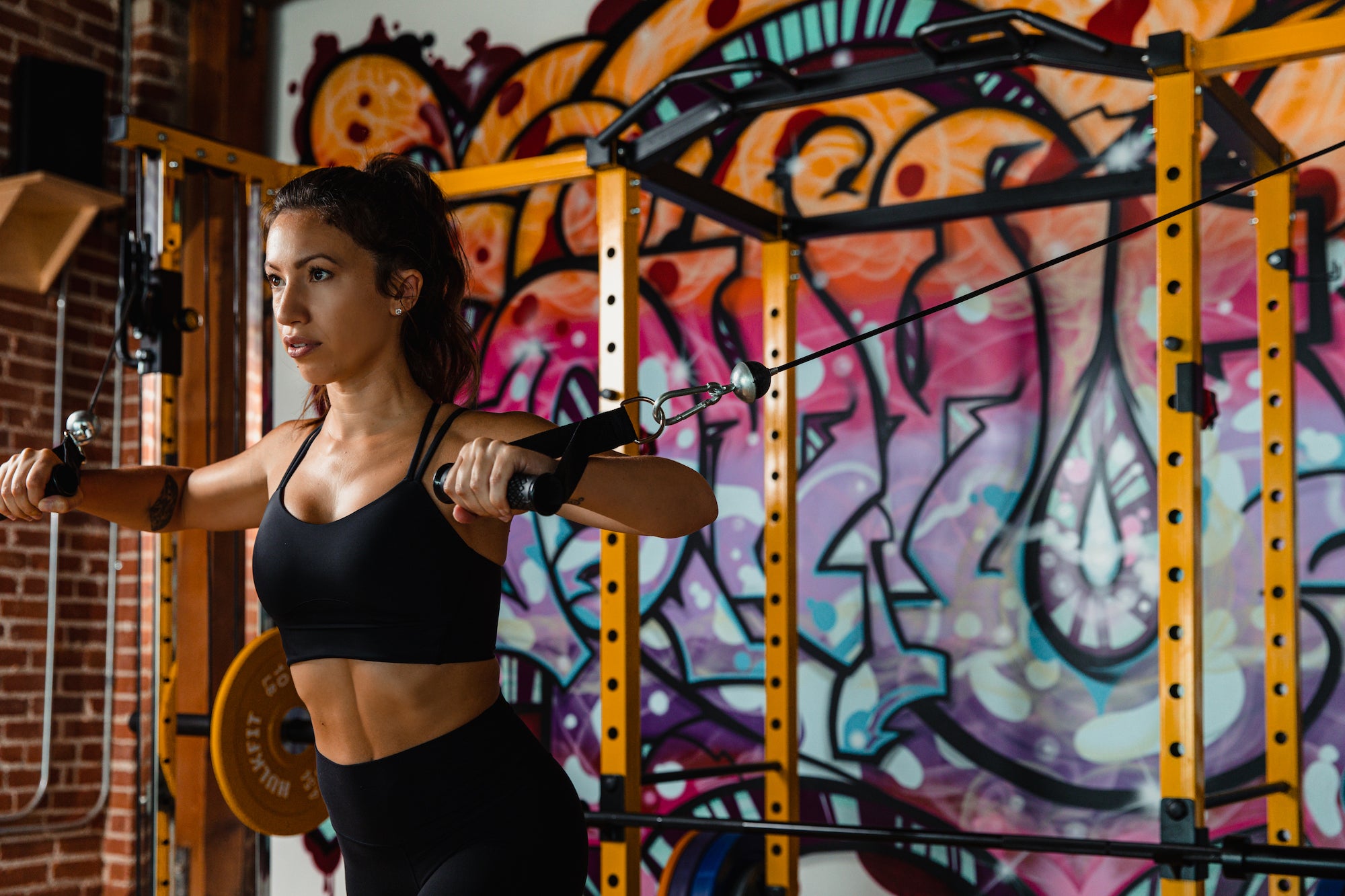
Are Weighted Bars right for you?
What
Weighted Bars are one of the most functional pieces of workout equipment today. They were originally developed in the 80’s, but as time progressed, they became less common and less relevant to most people.
The bars are constructed of a weighted metal core with a soft, hand forming pad on the exterior, which makes them one of the first ergonomic products on the market. It makes it easy to use and calluses are not as likely to form, however that depends on how much you use them. Each end is capped with different colors of plastic caps that display the weight for easy identification. The caps are designed in a squared shape so that the bar does not roll away when you put it down between exercises or workouts. The vast majority of the bars on the market range from a low of 5 pounds to a high of 35 pounds, usually in 5 pounds increments. However, some of the weighted bars may vary and are arranged in 4-pound increments.
Biggest Advantage - Be Adventurous!
The greatest benefit of these bars is that they can be used on the go and do not have to be relegated to a gym like environment. They are transportable and can be taken to the beach, the mountains, the desert, and beyond!

Who
The weighted bars can be used by anyone at any time! However, we will break down the group of users below by segment. The following information has been researched thoroughly in order to give you the best information possible.
Youth - Don’t Go Too Heavy, Too Soon!
High school and collegiate athletes can use weighted bars to train for their respective sports. This is a great entry point for strength training, especially for high schoolers. You can target specific areas of the body to tone and increase your workout capacity by getting your form down before going into strength training.
Track & field, golf, baseball, and softball athletes would typically use these products to help improve weight transferring these sports require. Transferring weight from one part of the body to another is difficult and it requires numerous hours of dedication to your training before it becomes second nature. Core rotation is another important aspect to develop for the sports mentioned above. Strengthen until it becomes a natural movement during competition.
For example, baseball and softball athletes would utilize the bars to correct their swing, so they can hit the ball at a specific angle or trajectory. In situational hitting, let’s say that there is a runner on third base with one out, the batter wants to hit a line drive base hit or hit the ball at the bottom and drive it into the outfield on the fly so that the runner on third base can tag up and score once the ball is caught in the outfield. The key is depth of the fly ball.
Adults - Functional Training and Space Saving
The main group of weighted bar users are largely made by adults who need the flexibility of an intense workout with the ability to tone their entire body by targeting multiple muscle groups. “The Body Bar” revolutionized the bars and continued to evolve by focusing on training videos through DVD productions and sales of those DVD’s. The popularity of weighted bars has been steadily increased amongst dedicated workout warriors with the emergence of functional training routines. This helps mitigate the need for large barbells, weight plates, and dumbbells, which requires more space.
Older Adults - Fountain of Youth….Put a spring in your step!
Strength training amongst older adults often involves low intensity workouts without significant pressure on joints. As we all get older, those joints age with us. In a retirement community setting, group classes are offered in most cases, and these bars can help remedy the loneliness one might be facing, giving them a reason to get moving. Lower weighted bars are much easier to maneuver and use without losing balance, which will increase mobility and give them a spring in their step.
Maybe ballroom dancing is next?
Medical/Rehab - “Don’t Give Up, Don’t Ever Give Up”
Weighted bars are marketed alternatively as medical supplies. These are typically used in rehabilitation facilities that come straight from surgery or when they leave a hospital. During the recovery process, you may need to use lighter weights to begin the healing process and to steadily increase strength in the damage area.
Example - My college baseball friend from Colorado State University - Pueblo had his ulnar collateral ligament torn and needed “Tommy John” surgery to repair it. This medical procedure was named after a professional baseball player of the 1960’s and 1970’s who tore the ligament in half, which required a brand type of procedure that was never done before that time. It requires re-connecting the ligament to the elbow and takes a lengthy period of time to recover fully (usually around 6 months before you can rehabilitate).
Once he recovered enough from the surgery, he needed to rehabilitate the injury. This was around the time I needed help losing weight and needed a dedicated workout partner. We were the perfect match and the stars aligned!
Our training sessions began with lifting 5-pound weights, swimming, and resistance band training with a mix of calisthenics. It was at this particular moment that I was exposed to weighted bars. Never knew about the functional use of the weighted bars until we began incorporating them in our workouts. We did floor presses, back squats, shoulder presses, and double arm curls just to name a few. In a matter of months, he was able to get back to where he was before, and I got to learn what dedication it takes to keep going even through minor setbacks.
As the late Jim Valvano said, “Don’t give up, Don’t ever give up”.

Types of Training
Balance Training
Circuit Training
General Strength & Conditioning
Interval Training
Specific Uses
Barre
Baseball
Golf
Martial Arts
Pilates
Physical Therapy
Softball
Track & Field
Yoga

10 Examples of Exercises - Can do in any order, get creative!
- Back Squats or Front Squats
- Lunges
- Aerobic Steppers or Step Up’s
- Shoulder Presses
- Bicep Curls or Reverse Curls
- Bench Press or Floor Press
- Bent Over Row
- Russian Twists - Seated or Standing
- Hip Thrusters
- Sit-up’s - Bar extended out in front

Example of use - Baseball & Softball - modified standing Russian Twist
- Hold the bar in a back squat set up with your feet shoulder width apart.
- Twist and rotate your body side to side. Similar to a top.
- The core muscles rotating side to side will increase the rotational force your body can exert. NOTE When a pitch comes, your body twists towards the ball and the impact will help increase the speed of the ball off the bat and the distance will increase with the correct launch angle.
- This motion transfers to the arms, from shoulders, to biceps and triceps, to the forearms, and extends to the hands.
Training Routines & Visual Reference
Try this 30-minute lower body workout
4 - 7 Sets
- 2 x 50 Stair Steppers - Lead with each leg
- 25 x Squats
- 25 x Lunges - Alternate with each leg
- 30 seconds - Squat Holding Position
- 30 seconds - 1 Leg Squat Holding Position
Repeat
Try this 30-minute core workout
4 - 7 Sets
- 25 Sit Ups with bar extended in front
- 25 Russian Twists - Standing or Seated
- 1 Minute Superman Posture - Lay down on abdomen
- 1 Minute Kayakers
- 1 Minute Kayaker Holding Position
Repeat
Try this 30-minute upper body workout
4 - 7 Sets
- 25 Bench Presses or Floor Presses
- 25 Bent Over Rows
- 25 Reverse Bicep Curls
- 25 Shoulder Presses
- 1 Minute Forearm Twists - each arm


